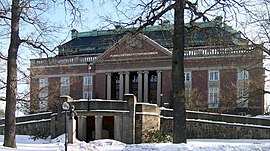Sweden's national academy of sciences From Wikipedia, the free encyclopedia
The Royal Swedish Academy of Sciences (Swedish: Kungliga Vetenskapsakademien) is one of the royal academies of Sweden. Founded on 2 June 1739, it is an independent, non-governmental scientific organization that takes special responsibility for promoting natural sciences and mathematics and strengthening their influence in society, whilst endeavouring to promote the exchange of ideas between various disciplines.
Kungliga Vetenskapsakademien | |
 | |
 Main building of the Royal Swedish Academy of Sciences in Stockholm | |
| Formation | 2 June 1739 |
|---|---|
| Headquarters | Stockholm, Sweden |
| Membership | 470 Members (including 175 Foreign members) |
President | Birgitta Henriques Normark |
Secretary General | Hans Ellegren |
| Website | www |
The goals of the academy are:
Every year, the academy awards the Nobel Prizes in physics and chemistry, the Sveriges Riksbank Prize in Economic Sciences in Memory of Alfred Nobel, the Crafoord Prize, the Sjöberg Prize and several other awards. The academy maintains close relations with foreign academies, learned societies and international scientific organizations and also promotes international scientific cooperation. The Academy of Sciences is located within the Stockholm region's Royal National City Park.

The academy has elected about 1,700 Swedish and 1,200 foreign members since it was founded in 1739. Today, the academy has about 470 Swedish and 175 foreign members which are divided into ten "classes", representing ten various scientific disciplines:[9]
This section needs additional citations for verification. (February 2024) |

The following persons have served as permanent secretaries of the academy:

The transactions of the academy (Vetenskapsakademiens handlingar) were published as its main series between 1739 and 1974. In parallel, other major series have appeared and gone:
The academy started publishing annual reports in physics and chemistry (1826), technology (1827), botany (1831), and zoology (1832). These lasted into the 1860s, when they were replaced by the single Bihang series (meaning: supplement to the transactions). Starting in 1887, this series was once again split into four sections (afdelning), which in 1903, became independent scientific journals of their own, titled "Arkiv för..." (archive for...). These included:
Further restructuring of their topics occurred in 1949 and 1974. Other defunct journals of the academy include:
The academy was founded on 2 June 1739 by naturalist Carl Linnaeus, mercantilist Jonas Alströmer, mechanical engineer Mårten Triewald, civil servants Sten Carl Bielke and Carl Wilhelm Cederhielm, and statesman/author Anders Johan von Höpken.[12]
The purpose of the academy was to focus on practically useful knowledge, and to publish in Swedish in order to widely disseminate the academy's findings. The academy was intended to be different from the Royal Society of Sciences in Uppsala, which had been founded in 1719 and published in Latin. The location close to the commercial activities in Sweden's capital (which unlike Uppsala did not have a university at this time) was also intentional. The academy was modeled after the Royal Society of London and Academie Royale des Sciences in Paris, France, which some of the founding members were familiar with.[citation needed]
Seamless Wikipedia browsing. On steroids.